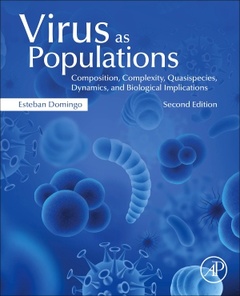Description
Virus as Populations (2nd Ed.)
Composition, Complexity, Quasispecies, Dynamics, and Biological Implications
Author: Domingo Esteban
Language: English
Subject for Virus as Populations:
426 p. · 19x23.3 cm · Paperback
Description
/li>Contents
/li>Readership
/li>Biography
/li>Comment
/li>
Virus as Composition, Complexity, Quasispecies, Dynamics, and Biological Implications, Second Edition, explains the fundamental concepts surrounding viruses as complex populations during replication in infected hosts. Fundamental phenomena in virus behavior, such as adaptation to changing environments, capacity to produce disease, and the probability to be transmitted or respond to treatment all depend on virus population numbers. Concepts such as quasispecies dynamics, mutations rates, viral fitness, the effect of bottleneck events, population numbers in virus transmission and disease emergence, and new antiviral strategies are included.
The book's main concepts are framed by recent observations on general virus diversity derived from metagenomic studies and current views on the origin and role of viruses in the evolution of the biosphere.
grad students, researchers, med students and investigators in virology, microbiology, and infectious disease; pharmacologists and vaccinologists; theoretical biologists; evolutionary biologists.
- Features current views on key steps in the origin of life and origins of viruses
- Includes examples relating ancestral features of viruses with their current adaptive capacity
- Explains complex phenomena in an organized and coherent fashion that is easy to comprehend and enjoyable to read
- Considers quasispecies as a framework to understand virus adaptability and disease processes




